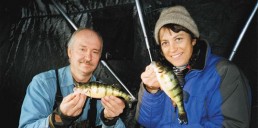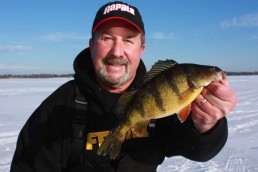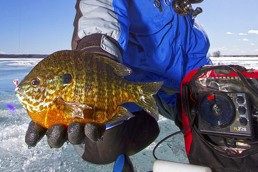Slow does the Trick to Entice Winter Panfish
SHARE THIS POST
There was a continuous hissing as a north wind drove loose snow and ice crystals across Lake St. Clair’s winter ice.
Bob Kook, “Bobber” Anne and I were racing a pair of four-wheelers—one with a pop-up ice shanty in tow—across the east bay’s frozen surface. It was cold, too cold. At 82 years of age, this wasn’t my thing to do to go fishing.
Bob, a connoisseur of winter perch fishing, was in charge.
Once we arrived at our host’s chosen spot, Bob took only a few minutes to set up the shanty, drill the holes and fire up the propane stove. Once out of the freezing windstorm, I shivered up a bit of body heat, aided by the warmth provided by the purring propane heater. Thumper, my yellow lab, had crowded in immediately as the shanty took shape. It had to be cold out if the dog couldn’t stand it. Time to fish!
We’d use Flickers, Gapen’s slab spoons. Bob selected a shad hologram finish, Anne a chartreuse glow, and I picked a red and white glow color.
“Bob, let’s film this. I’ll drop the underwater lens down and start filming,” Anne suggested we dropped Flickers into the 12 feet of water.
As the underwater lens reached 6 inches off the gravel bottom, fish began to appear. They, for unknown reasons, seemed drawn to the new item that had entered their world. This didn’t surprise Anne and me. We’d been doing a lot of underwater filming during the last five years, and had found similar “fish appeal” to the entry of the lens many times before.
Actually, smallmouth bass had been easily drawn to the underwater apparatus, moving in to touch the lens with their noses.
Below us was a large school of perch, a scattering of pumpkinseeds and a single 6- to 7-pound pike that seemed very interested in the smaller perch. Mr. Pike was about 5 feet to the side of where our lens landed. Later he’d see his demise when he decided Anne’s Flicker was his to eat.
We’d tip our Flickers with waxworms and our anise-scented Red Balls. Bob had remarked that perch love Red Ball eggs while the pumpkinseeds would be drawn to the waxworm-tipped Flickers.
We’d use that age-old technique of dropping our Flickers into the dusty gravel bottom, lift up six inches and quiver the lure ever so slightly.
Are you enjoying this post?
You can be among the first to get the latest info on where to go, what to use and how to use it!
Instantly, as Bob’s red-ball-loaded Flicker was raised off bottom, a 10-inch perch sucked in the Red Ball and was rudely retrieved up out of the ice hole. Thumper now got into the action as she tried to retrieve the flopping fish on the shanty’s floor. Needless to say, we were crowded enough without an overanxious 85-pound Labrador floundering about. Throughout all this commotion, I hooked up to divert Thumper’s attention. Finally, with the two perch flopping in the 5-gallon pail, we managed to draw the dog’s attention to looking into the bucket. It didn’t last long, maybe a couple minutes, when Thumper leaned over Anne’s ice hole to watch for what was to come.
On the DVD we made that day, Anne actually got a video shot of Thumper with her nose down in the ice hole from below. That dog has always believed that fishing and the fish we catch are critters to retrieve. During the summer, if you fail to net a fish soon enough, that dog is out of the boat and hot after your hooked fish.
Dropping lures into the bottom as a presentation creates a sand or dust boil, which will bring fish in from as far away as 50 to 75 feet. So it was on that frozen day. We’d taken seven or eight perch from 9 to 12 inches when I discovered, by viewing the underwater monitor, we’d tripled the size of the school below. Suddenly we were drowning in panfish, or so to speak.
“Oowiee,” came Anne’s voice as the next fish popped out of the ice hole. She’d caught a very large pumpkinseed in full winter colors.
“It’s beautiful, guys. Looks like a tropical fish,” pronounced our fishing companion. It too would be kept for the frying pan that night. If it was half as good eating as winter perch, we were in for a treat.
Though Bob was taking his share, we all decided it was the red and white Flicker tipped with Red Ball that was producing best. Changes were made and our “fish-through-the-holes” count increased.
One of the lessons learned was that the panfish below us seemed to prefer a rising bait; a slow rising Flicker couldn’t be passed up. Why? I’m not sure! Maybe they felt it was about to get away from them. Another lesson was that any jig worked in rapid jerks often was ignored. Often as the panfish become interested in our offerings, if you jerked the Flicker, the one looking at it would dart away causing some of the surrounding school to do the same. The Red Ball tip was definitely usually the trigger that caused a soft-mouth strike. By that I mean the attacking perch would slowly come in on the Red Ball and softly suck it in. Very seldom did I see a flashing hard hit like during summer days.
The conclusions are: a slow rising bait, a Red Ball egg and a Flicker are tools to entice winter panfish, and perch. I can also tell my readers this old guy is about at the end of his ice fishing days. Note the photo of me in the column—frozen.
If you are in need of Flickers and Red Balls go to Gapen’s website at gapen.com. They’re both available if your local sports shop doesn’t have them.
Until next month, remember to relax, savor and enjoy our great outdoors. It’s yours to preserve for future generations.
MWO
SHARE THIS POST
Did you enjoy this post?
You can be among the first to get the latest info on where to go, what to use and how to use it!
Dan Gapen
Considered one of the world’s leading river anglers, Dan Gapen, Sr. has shared his knowledge with MidWest Outdoors readers and viewers for more than 40 years. He is a member of all three Fishing Halls of Fame—International, National Freshwater, and Minnesota. He has an immense grasp of the world’s fisheries. He may be contacted at 877-623-2099.
@TheGapenCompany.



